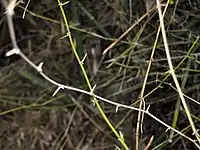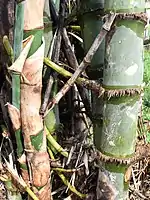| Bambusa blumeana | |
|---|---|
 | |
| B. blumeana leaves | |
 | |
| Thorny bamboo: B. blumeana habit | |
| Scientific classification | |
| Kingdom: | Plantae |
| Clade: | Tracheophytes |
| Clade: | Angiosperms |
| Clade: | Monocots |
| Clade: | Commelinids |
| Order: | Poales |
| Family: | Poaceae |
| Genus: | Bambusa |
| Species: | B. blumeana |
| Binomial name | |
| Bambusa blumeana | |
| Synonyms | |
|
Schizostachyum durie Rupr. | |
Bambusa blumeana,[1] also known as spiny bamboo or thorny bamboo, is a species of clumping bamboo occurring in Tropical Asia.[2][3][4]
This bamboo is known locally as: kawayang tinik in the Philippines, buluh duri in Malay and tre gai or tre lá ngắn in Vietnam.[5]
Description
Culms (stems) of Bambusa blumeana are up to 25 m (82 ft) long and slightly arched. At the base they are up to 15 cm (6 in) thick with walls 2 to 3 cm (0.8 to 1.2 in) thick, or may be solid. The stem consists of a number of short sections separated by nodes. The main branches are borne on the upper half of the culms, those on the lower part being slender and armed with thorns. The leaves are alternate, lanceolate, and up to 20 cm (8 in) long, and one grows from each node, with the lower part of the leaf sheathing the stem.[6]
Distribution and habitat
Where Bambusa blumeana originated is unclear, but it may have been native to Indonesia and Borneo. Its range now includes the Philippines, Thailand, Vietnam, southern China and Japan. It has also been introduced to Madagascar, Guam, and some other Indo-Pacific islands. Its natural habitat is hillsides, valley bottoms and stream banks, where it forms tangled thickets, at altitudes up to about 300 m (1,000 ft). It tolerates acid soils, clay and occasional flooding, but not saline soils.[5]
Uses
Young shoots of Bambusa blumeana are boiled and eaten as a vegetable, being harvested when they first emerge from the ground. The plant is used as a living fence between fields, as a windbreak around homesteads and to prevent erosion on river banks. The poles are useful as a lightweight scaffolding but are not durable enough for building construction; other uses include basket-making, furniture manufacture, parquet, toys, chopsticks and kitchen utensils.[7] The culms of this bamboo, along with those of Dendrocalamus asper, are the main source of bamboo pulp used to make paper.[8]
Bambusa blumeana is sometimes cultivated as an ornamental plant. Propagation can be from seed, but the plant only flowers once every few years, so seed is often unavailable. Clumps can be divided when new growth is commencing, or culms can be cut into sections and used as cuttings.[9]
Gallery
 Bambusa blumeana's spines
Bambusa blumeana's spines Bambusa blumeana's lower culms
Bambusa blumeana's lower culms
References
- ↑ J.J.Roemer & J.A.Schultes, 1830 In: Syst. Veg. 7: 1343
- ↑ "Bambusa blumeana Schult. f. Plant Profile". USDA Natural Resources Conservation Service. Retrieved 2009-05-21.
- ↑ "Bambusa blumeana". The Board of Trustees, Royal Botanic Gardens, Kew. Retrieved 2009-05-21.
- ↑ "Bambusa blumeana". Germplasm Resources Information Network. Agricultural Research Service, United States Department of Agriculture. Retrieved 2009-05-21.
- 1 2 Ohrnberger, D. (1999). The Bamboos of the World: Annotated Nomenclature and Literature of the Species and the Higher and Lower Taxa. Elsevier. pp. 256–257. ISBN 978-0-08-054238-6.
- ↑ Schröder, Stéphane. "Bambusa blumeana". Retrieved 2021-05-24.
- ↑ "Bambusa blumeana - Schult. & Schult.f." Plants for a Future. Retrieved 2021-05-26.
- ↑ Nanko, Hirko; Button, Allan; Hillman, Dave (2005). The World of Market Pulp. The World of Market Pulp. p. 256. ISBN 978-0-615-13013-2.
- ↑ Fern, Ken. "Bambusa blumeana - Schult. & Schult.f." Tropical Plants Database. Retrieved 2021-05-26.
External links
 Media related to Bambusa blumeana at Wikimedia Commons
Media related to Bambusa blumeana at Wikimedia Commons Data related to Bambusa blumeana at Wikispecies
Data related to Bambusa blumeana at Wikispecies